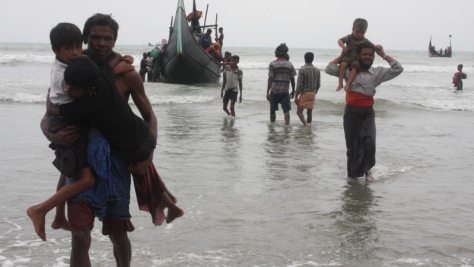Rohingya emergency
The Rohingya are a stateless Muslim minority in Myanmar. The latest exodus began on 25 August 2017, when violence broke out in Myanmar’s Rakhine State. The vast majority of Rohingya refugees reaching Bangladesh are women and children, including newborn babies. Many others are elderly people requiring additional aid and protection.
The two existing refugee camps of Kutupalong and Nayapara, established in the 1990s, were already home to over 33,000 Rohingya refugees before this influx. Now the camps’ population has soared to an estimated 77,000, well beyond existing capacity, with many new arrivals taken in by refugee families or hosted in the camps’ schools, community centres and other covered structures.
“They burnt our house and drove us out by shooting. We walked for three days through the jungle.”
–Mohammed, who fled to Bangladesh with his family of seven, including a baby born along the way
The vast majority of newly arriving refugees are now living outside the camps, in makeshift settlements and temporary shelters – often nothing more than tarpaulin held on bamboo poles. Infrastructure and services are overstretched. Other refugees continue to arrive in extremely poor condition. We are working with the Government of Bangladesh and other authorities to identify suitable spaces to accommodate them.
As more refugees arrive every day there is an acute need for emergency shelters and land to them, blankets and other forms of aid. To lessen the risk of waterborne and airborne diseases, refugees and host communities urgently need more clean water, health care and other supplies. Pregnant women, young children and the elderly are especially vulnerable.
What is UNHCR doing to help?
UNHCR is leading the emergency response in the two camps, Kutupalong and Nayapara, where we are providing life-saving assistance and protection to the Rohingya refugees, in close collaboration with partners and authorities.
We are providing emergency shelter in many forms and wherever available, ranging from plastic sheeting to temporary bamboo sheds to common buildings, such as schools, being used as temporary shelters.
We are also distributing blankets, kitchen sets, jerrycans, solar lanterns, sleeping mats, and mosquito nets. The first two UNHCR emergency airlifts carrying 3,500 relief items and 1,700 family tents arrived in Dhaka on 13 September – enough to meet the immediate needs of 25,000 refugees. Further flights are being planned.
We continue to identify the most vulnerable new arrivals, such as unaccompanied children, pregnant women, the elderly and the disabled. Our protection staff are working to establish child-friendly spaces and to prevent sexual and gender-based violence.
UNHCR urgently requires an estimated US$30 million to respond to the ongoing emergency in Bangladesh, which was already coping with devastating floods before the refugee influx. Of this amount, US$6 million is immediately needed for shelter and core relief items for Rohingya refugees. Much more needs to be done to meet the acute needs of children, women and men fleeing conflict.
Reports and links
- UNHCR's Emergency Response in Bangladesh (September 2017)
- Supplementary Appeal – Myanmar Refugee Emergency Response In Bangladesh (Sept 2017 – Feb 2018)

